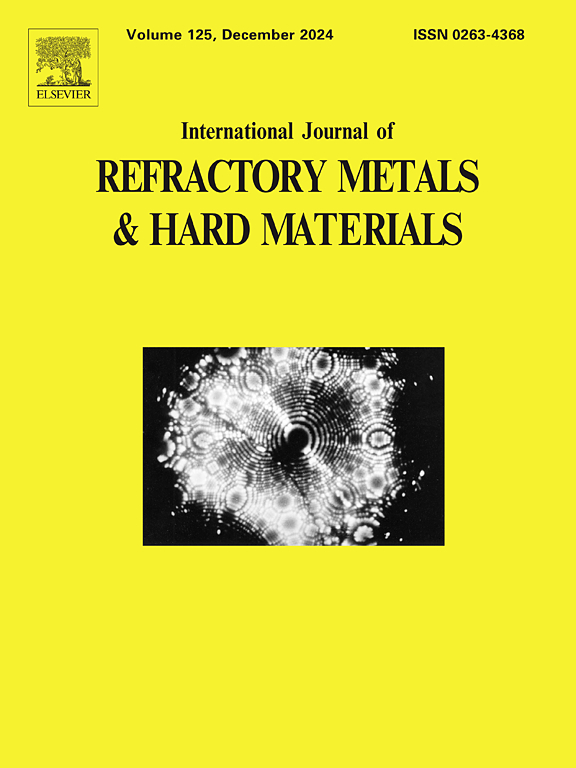Surface structure of lapping discs improves the processing performance and self-sharpening ability of agglomerated diamond abrasives
IF 4.2
2区 材料科学
Q2 MATERIALS SCIENCE, MULTIDISCIPLINARY
International Journal of Refractory Metals & Hard Materials
Pub Date : 2025-04-27
DOI:10.1016/j.ijrmhm.2025.107208
引用次数: 0
Abstract
Agglomerated diamond (AD) abrasives have been proven applicable in the machinability of polyurethane lapping discs. However, the processing performance, material removal behaviour, and self-sharpening mechanisms of AD abrasives on lapping discs with different surface structures remain unclear. Therefore, in this study, we designed different groove-structured lapping discs and combined them with AD abrasives to conduct lapping experiments on sapphire wafers to investigate the processing performance of groove-structured lapping discs on AD abrasives and reveal the material removal behaviour and dynamic self-sharpening mechanism of AD abrasives. The results show that the groove-structured lapping disc exerts a guiding and restraining effect on the AD abrasives, improving processing uniformity and reducing their wear rate. Additionally, the groove structure enhances the vortex effect of the lapping slurry, which further improves the self-sharpening ability and processing performance of the AD abrasives. The polyurethane disc with a cylindrical groove-2# structure and a size ratio 1:100 produced the best processing results. At a processing cycle of 30 min, the average particle size of AD abrasive was 26.2 μm, which minimized micro-fracture and resulted in a processing effect with an material removal rate (MRR) of 2.51 μm/min and surface roughness (Ra) of 10.42 nm. The AD abrasives remove the surface material of the workpiece through a combination of two-body sliding friction and three-body rolling friction within the groove-structured disc, achieving superior processing efficiency and quality.
研磨盘的表面结构提高了团聚金刚石磨料的加工性能和自锐性
聚类金刚石(AD)磨料已被证明适用于聚氨酯研磨盘的切削加工。然而,AD磨料在不同表面结构研磨盘上的加工性能、材料去除行为和自锐机制尚不清楚。因此,在本研究中,我们设计了不同的凹槽结构研磨盘,并将其与AD磨料相结合,对蓝宝石晶圆进行研磨实验,研究凹槽结构研磨盘在AD磨料上的加工性能,揭示AD磨料的材料去除行为和动态自锐机理。结果表明:沟槽结构的研磨盘对AD磨料具有引导和抑制作用,提高了加工均匀性,降低了磨料的磨损率;此外,沟槽结构增强了研磨浆的涡流效应,进一步提高了AD磨料的自锐能力和加工性能。采用2#圆柱槽结构,尺寸比为1:100的聚氨酯盘加工效果最好。加工周期为30 min时,AD磨料的平均粒径为26.2 μm,微断裂最小,材料去除率(MRR)为2.51 μm/min,表面粗糙度(Ra)为10.42 nm。AD磨具通过凹槽结构圆盘内两体滑动摩擦和三体滚动摩擦的结合去除工件表面材料,实现卓越的加工效率和质量。
本文章由计算机程序翻译,如有差异,请以英文原文为准。
求助全文
约1分钟内获得全文
求助全文
来源期刊
CiteScore
7.00
自引率
13.90%
发文量
236
审稿时长
35 days
期刊介绍:
The International Journal of Refractory Metals and Hard Materials (IJRMHM) publishes original research articles concerned with all aspects of refractory metals and hard materials. Refractory metals are defined as metals with melting points higher than 1800 °C. These are tungsten, molybdenum, chromium, tantalum, niobium, hafnium, and rhenium, as well as many compounds and alloys based thereupon. Hard materials that are included in the scope of this journal are defined as materials with hardness values higher than 1000 kg/mm2, primarily intended for applications as manufacturing tools or wear resistant components in mechanical systems. Thus they encompass carbides, nitrides and borides of metals, and related compounds. A special focus of this journal is put on the family of hardmetals, which is also known as cemented tungsten carbide, and cermets which are based on titanium carbide and carbonitrides with or without a metal binder. Ceramics and superhard materials including diamond and cubic boron nitride may also be accepted provided the subject material is presented as hard materials as defined above.

 求助内容:
求助内容: 应助结果提醒方式:
应助结果提醒方式:


